How To Set Gps And Camera In Different Time Zones
Geocoding photographs with location data is a useful and fun manner to go along runway of photo locations and visualize trips that y'all have taken.
I personally like seeing a map view of my favorite photos and also like to have a record of exactly where a particular photograph was taken, particularly when I am in remote areas.
Most DSLR and mirrorless cameras practise not have born GPS receivers. Some allow you to plug in an external GPS receiver, while others connect to a smartphone via Bluetooth to retrieve GPS data from the phone each time a photo is taken.

There are a couple of disadvantages to these solutions. Attaching a GPS receiver straight to a camera consumes a lot of power. It tin can be an constructive solution, but it requires an additional piece of hardware, and you will need to bear actress batteries due to dramatically reduced bombardment life.
Using a smartphone'due south GPS capabilities via Bluetooth can exist a convenient solution for modern cameras that back up information technology. However, telephone-based GPS can be somewhat inaccurate compared to dedicated GPS devices. It also drains power more quickly on your smartphone.
Adobe's Lightroom Classic has a Map module that is able to display map data for a given set up of photos. It also has the ability to auto-tag location data on photos using a GPS Commutation Format (GPX) file generated by a GPS device.
For longer excursions to remote areas, I prefer to track my GPS location using a dedicated GPS device. Currently, I utilise either my Garmin eTrex Touch 35t or Garmin inReach Mini satellite communicator. Withal, in that location are many different GPS devices and even watches that can generate GPX data.
Ensure time and engagement are fix correctly on photographic camera
Auto-tagging location information on photos using Lightroom matches the time a picture is taken with the corresponding fourth dimension and location in the GPX file from a GPS device.
For location motorcar-tagging to work, the date and time must be set correctly on the photographic camera body, preferably with the correct time zone for your location.
To correct time zones in Lightroom, highlight the group of photos that need to be stock-still in the Library module, then click the push button side by side to Capture Time.
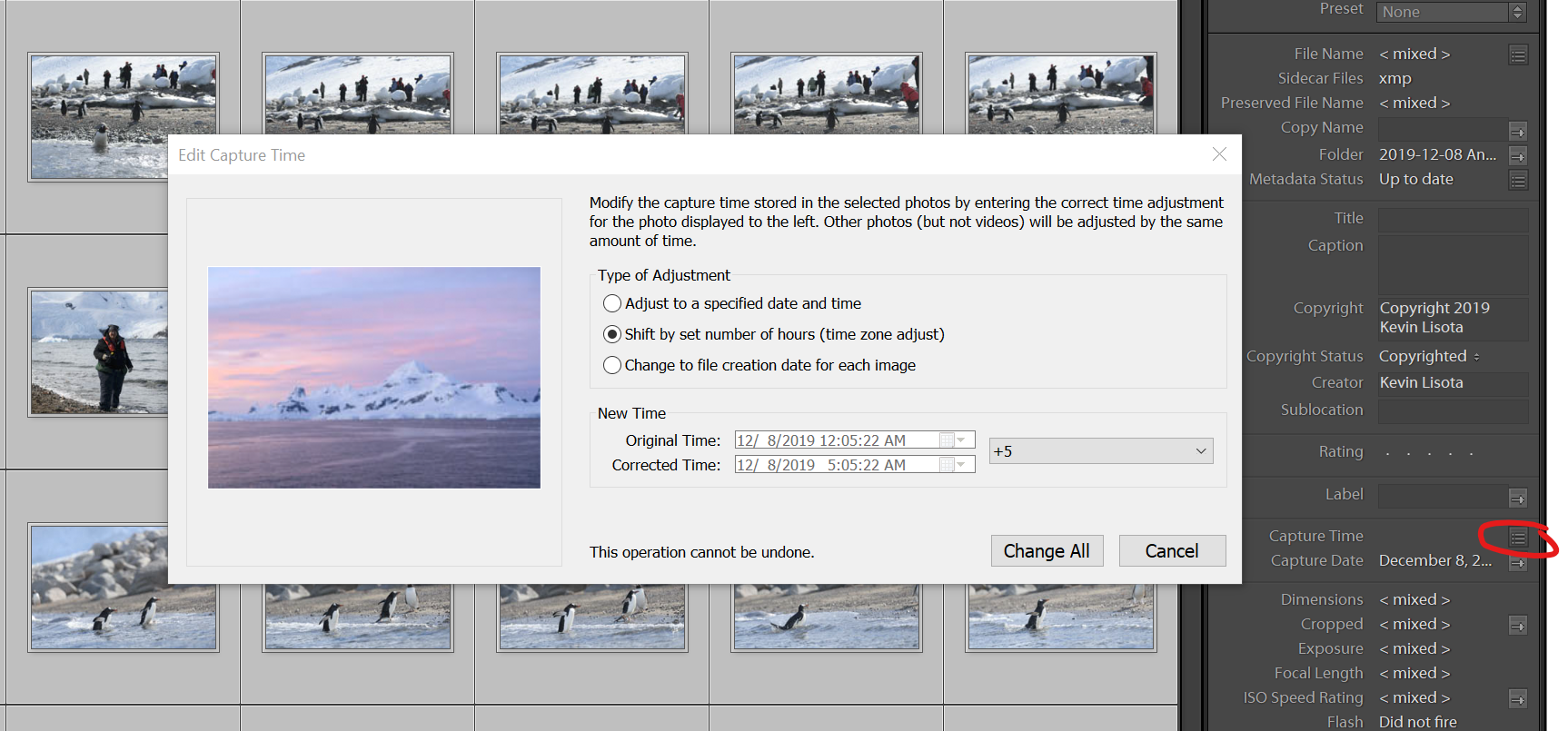
In the dialog box, choose "Shift by fix number of hours (time zone adjust)" and so add or subtract the time zone commencement. In my case, the photos were taken on the Antarctic Peninsula at Argentina Fourth dimension (UTC -3) just recorded on my photographic camera using Pacific Standard Time (UTC -viii), so I had to add +v hours to make the photograph capture time right.
Agreement GPS date and time formats
Lightroom uses GPX files from GPS devices to auto-tag location information. GPX files store a serial of latitude, longitude and elevation points at sequential times.
The time in a GPX file is ever stored in Coordinated Universal Time (UTC). UTC time is the time standard by which the world coordinates clocks and time, and is not adjusted for daylight savings time. Information technology is sometimes referred to as Greenwich Hateful Time.
The reward of storing GPS data in UTC time is that it is consistent no thing what time zone you are in and is not affected by changes in daylight savings fourth dimension.
Limitations of photographic camera date and fourth dimension in EXIF data
Digital cameras always store the date and time that a photo was created in the photo'south Exif data. Exif is a name for the Exchangeable epitome file format standard that defines how metadata is stored in prototype files.
The vast majority of cameras store Exif date and time without timezone data, making the date and time ambiguous when trying to match information technology with UTC timestamps in GPS data. This will lead to location tagging mistakes if information technology is not corrected.
The Exif standard recently added the ability for cameras to include timezone information in their photograph timestamps, just few, if any, current cameras support information technology.
Auto-tag locations in Lightroom using GPX information
To auto-tag location data on photos in Lightroom, the first step is to select photos that need location information. Photos that were taken with a smartphone or on devices with GPS receivers may already take location data and can be excluded.
In Lightroom'due south Library module, select a folder or collection of photos. And so using the Library Filter at the elevation, click "Metadata." Change one of the 4 filters to show "GPS Data" and then click on "No Coordinates." At present choose Edit > Select All to select the batch of photos that need GPS location coordinates.
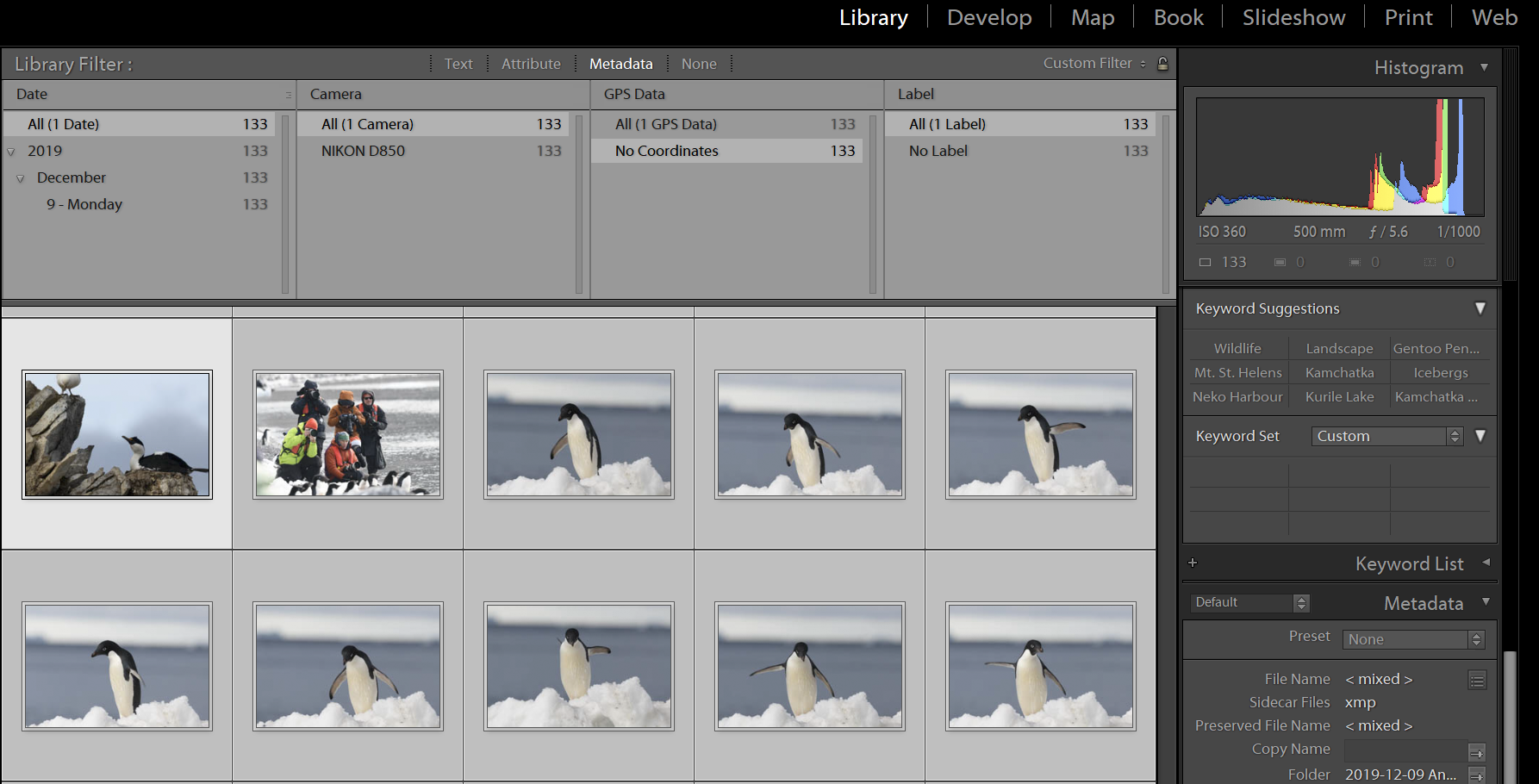
With the batch of photos selected, click on the Map module. And then in the carte select Map > Load Tracklog and select the GPX file from your GPS device. Notation that many GPS devices will require that you export from either from an app or website to get the proper GPX format needed past Lightroom. The tracklog volition display on a map.
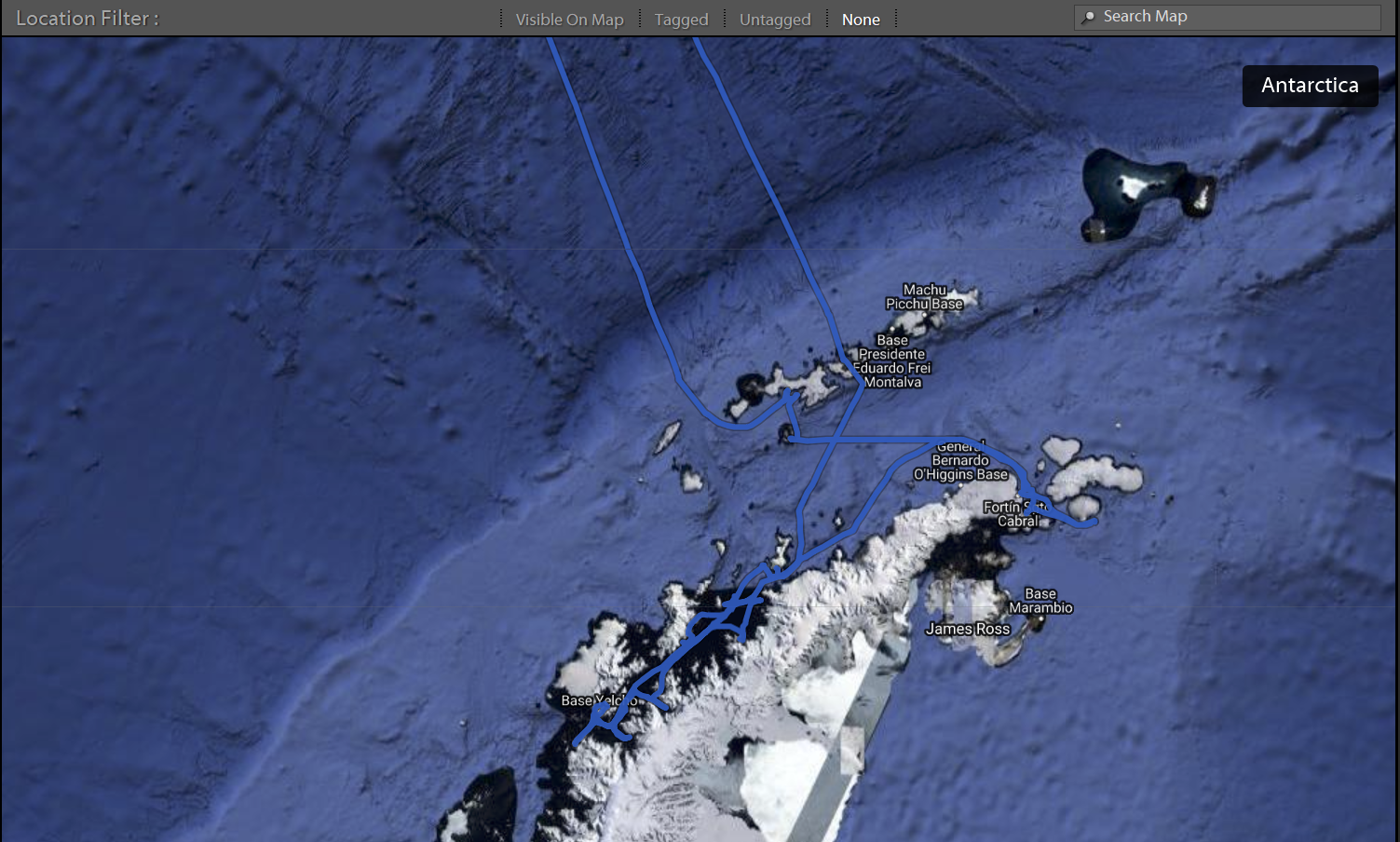
Fix timezone offsets
Auto-tagging photos is available from the menu by choosing Map > Tracklog > Auto-Tag Photos. Nevertheless, in nigh cases y'all beginning need to prepare the time zone difference between your photos' capture times and the UTC times listed in the GPS tracklog.
From the card, choose Map > Tracklog > Set Fourth dimension Zone Offset. This allows you to adjust the tracklog times to lucifer your photograph dates and times.
This is where it gets disruptive in Lightroom. In my example, the photo capture times are based on Argentina Time (UTC -3).
My computer is currently on Pacific Standard Fourth dimension (UTC -8). Lightroom assumes that the photograph capture times are the same as the computer'southward current time zone, which may or may not be correct.
If my photos were taken using Pacific Standard Fourth dimension (UTC -8), the tracklog needs to be starting time by +8 hours to lucifer the UTC times with the photo capture times.
Still, in my example, the photograph capture times are actually Argentina Time (UTC -three), so the tracklog fourth dimension zone offset needs to exist +8 hours for Pacific Standard Fourth dimension on my estimator, then subtracting -3 hours to adjust for Argentina Time, so the concluding offset is +5 hours.
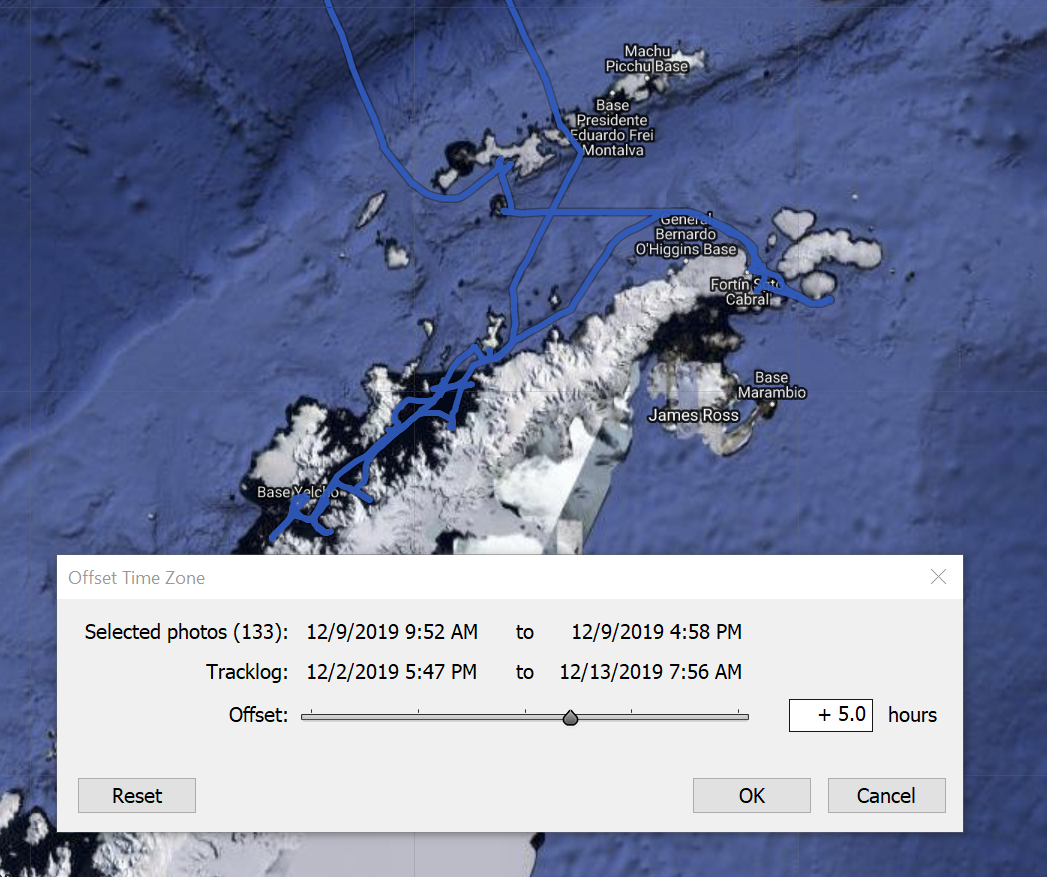
Automobile-tag and confirm locations on the map
Once the tracklog time zone offset is gear up, it is fourth dimension to machine-tag location data on the photos.
From the menu choose Map > Tracklog > Auto-Tag Photos. The images will appear on the map with tags.
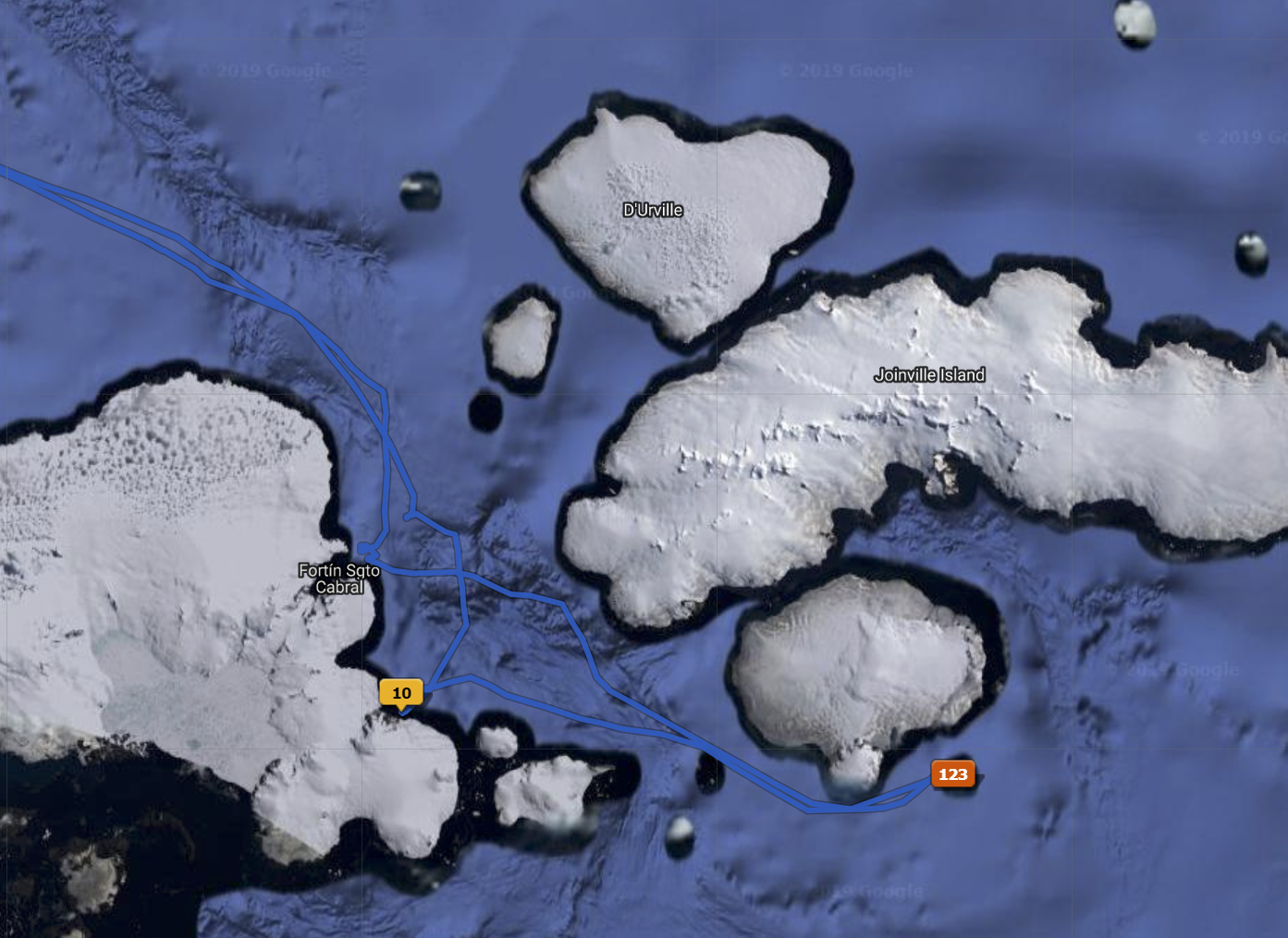
Before moving on in Lightroom, confirm that the locations make sense on the tracklog. If you have mixed upwards any of the time zone offsets, the images tin appear at wrong locations on the map.
A GPS track usually has reference points in your journey that volition make sense for the photos. In this example, the tracklog had two island landings where all of the photos were taken. When the fourth dimension zone kickoff was gear up correctly, all of the images are tagged with locations on those two islands.
If my time zone offset was wrong, the photos get tagged in a h2o location, which doesn't make sense for the trip that I took.
A second method to ensure that your tracklog time zone get-go is correct it to look at the start and cease times on the tracklog to see if they make sense. For example, if you began your GPS track at the offset of your hike at 8:00 AM and ended the hike at vi:00 PM, the get-go and end times nether Map > Tracklog > Time Zone Offset should reflect that in one case you have made the correct offset.
If your location tags don't look quite right, from the menu, select Edit > Undo Automobile-Tag Photos using Tracklog will remove the locations that you just fix.
Camera manufacturers demand to support fourth dimension zone in Exif data
Geocoding photos using GPS data would be much simpler if photographic camera manufacturers stored time zone data in the Exif metadata of each photo. Until that happens, merely make sure to lucifer your GPS data with photograph capture times using the correct fourth dimension zone starting time settings in Lightroom.
Source: https://kevinlisota.photography/2019/12/geocoding-photo-locations-using-lightrooms-map-module-and-gps-data/
Posted by: lenahancrioul.blogspot.com

0 Response to "How To Set Gps And Camera In Different Time Zones"
Post a Comment